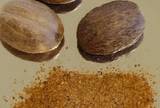Greek name and pronunciation:
Moschokaritho, μοσχοκάρυδο, pronounced mos-ho-KAH-ree-thoh (hard th, rhymes with “dough”)
At the market:
Both “whole nut” and ground powdered nutmeg are readily available commercially.
Physical characteristics:
The nut is a shiny dark brown in color, oval in shape, and about an inch long by 1/2-inch diameter. The nut’s interior is a lighter shade of brown to tan.
Usage:
Highly recommended to buy the nut and grate it for use. The taste is strong and it should be used in small quantities. It’s the aroma of béchamel sauce that infuses moussaka and pastitsio. It is used in white sauces and pureed potatoes. In very small quantities, it is used in cakes, marmelades, and glazed fruits.

Nutmeg herb
Substitutes:
allspice, cinnamon, ginger
Origin, History, and Mythology:
Arab traders of antiquity held a monopoly on the nutmeg trade until 1512 when explorer Vasco de Gamas discovered a route to the Spice Islands. For the next two centuries, the Portuguese and the Dutch guarded their succesive monopolies on nutmeg cultivation and marketing. During the mid-1700s, France and England succeeded in breaking the Dutch monopoly and establishing nutmeg plantations in other parts of the world.Today most of the world’s nutmeg is produced in the Spice Islands of Indonesia and the West Indies, especially Grenada – the “Nutmeg Island.”Used in excess (more than one nutmeg kernel (equivalent) served per person) nutmeg is a poison.
